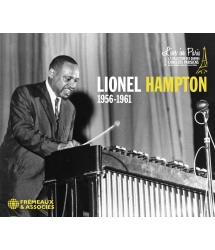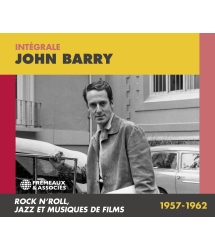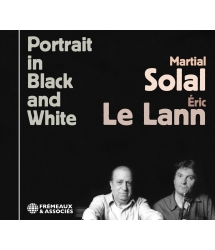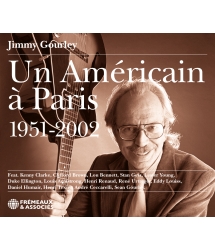- Our Catalog
- Philosophy
- Philosophers of the 20th century and today
- History of Philosophy (PUF)
- Counter-History and Brief Encyclopedia by Michel Onfray
- The philosophical work explained by Luc Ferry
- Ancient thought
- Thinkers of yesterday as seen by the philosophers of today
- Historical philosophical texts interpreted by great actors
- History
- Books (in French)
- Social science
- Historical words
- Audiobooks & Literature
- Our Catalog
- Jazz
- Blues
- Rock - Country - Cajun
- French song
- World music
- Africa
- France
- Québec / Canada
- Hawaï
- West Indies
- Caribbean
- Cuba & Afro-cubain
- Mexico
- South America
- Tango
- Brazil
- Tzigane / Gypsy
- Fado / Portugal
- Flamenco / Spain
- Yiddish / Israel
- China
- Tibet / Nepal
- Asia
- Indian Ocean / Madagascar
- Japan
- Indonesia
- Oceania
- India
- Bangladesh
- USSR / Communist songs
- World music / Miscellaneous
- Classical music
- Composers - Movie Soundtracks
- Sounds of nature
- Our Catalog
- Youth
- Philosophy
- News
- How to order ?
- Receive the catalog
- Manifesto
- Dictionnary











- Our Catalog
- Philosophy
- Philosophers of the 20th century and today
- History of Philosophy (PUF)
- Counter-History and Brief Encyclopedia by Michel Onfray
- The philosophical work explained by Luc Ferry
- Ancient thought
- Thinkers of yesterday as seen by the philosophers of today
- Historical philosophical texts interpreted by great actors
- History
- Books (in French)
- Social science
- Historical words
- Audiobooks & Literature
- Our Catalog
- Jazz
- Blues
- Rock - Country - Cajun
- French song
- World music
- Africa
- France
- Québec / Canada
- Hawaï
- West Indies
- Caribbean
- Cuba & Afro-cubain
- Mexico
- South America
- Tango
- Brazil
- Tzigane / Gypsy
- Fado / Portugal
- Flamenco / Spain
- Yiddish / Israel
- China
- Tibet / Nepal
- Asia
- Indian Ocean / Madagascar
- Japan
- Indonesia
- Oceania
- India
- Bangladesh
- USSR / Communist songs
- World music / Miscellaneous
- Classical music
- Composers - Movie Soundtracks
- Sounds of nature
- Our Catalog
- Youth
- Philosophy
- News
- How to order ?
- Receive the catalog
- Manifesto
- Dictionnary
CONCERTO POUR GUITARE
ALEXANDRE LAGOYA
Ref.: FA444
EAN : 3448960244428
Label : Frémeaux & Associés
Total duration of the pack : 37 minutes
Nbre. CD : 1
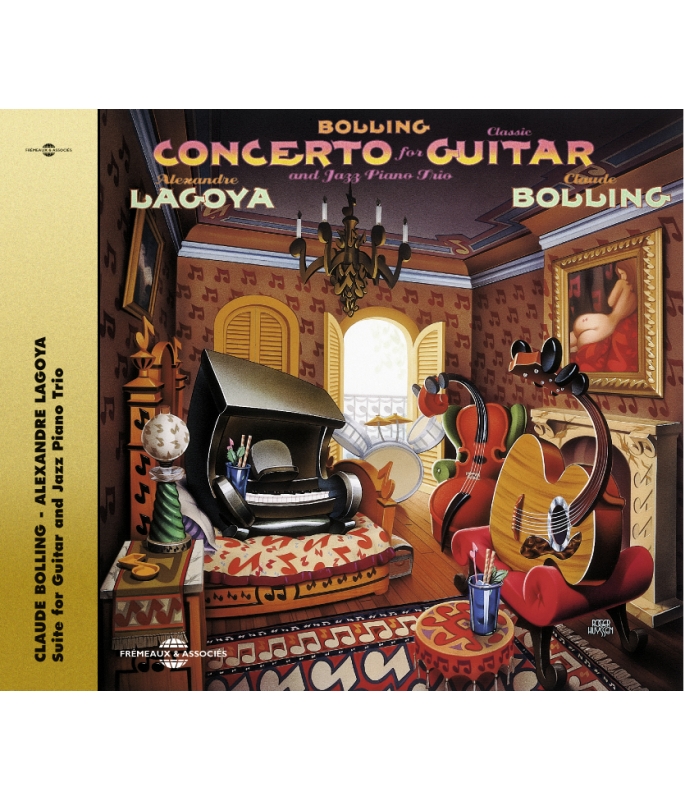
CONCERTO POUR GUITARE
- - RECOMMANDÉ PAR JAZZ NOTES
- - SÉLECTION JOURNAL DE MONTRÉAL
- - RÉCOMPENSÉ PAR TOUTE LA PRESSE AMÉRICAINE
CONCERTO POUR GUITARE
Through the composer, pianist and big band leader Claude Bolling, American music represented by Duke Ellington and Count Basie, became known and respected in Europe. Bolling, the pupil who became master, representing European music, introduced the ingenious mixture of jazz and classical music to the United States through his Suite for the flute and a piano jazz trio with Jean-Pierre Rampal which beat all records by staying in the Billboard charts for 530 weeks. Alexandre Lagoya, a leading guitarist of the XXth century, commissioned Claude Bolling for this concerto, another masterpiece of crossover
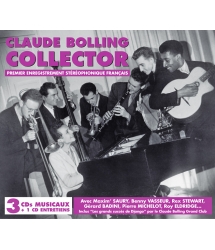
CLAUDE BOLLING MAXIM SAURY REX STEWART ROY ELDRIDGE
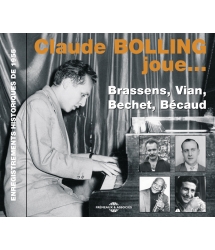
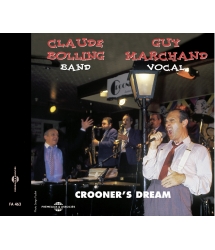
CROONER'S DREAM
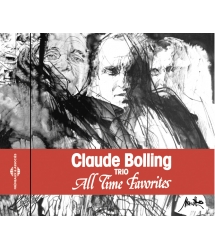
ALL TIME FAVORITES
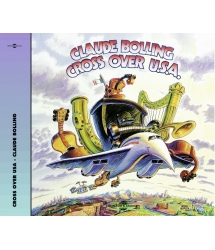
Rampal, Nordmann, Touvron, Fontanarosa...
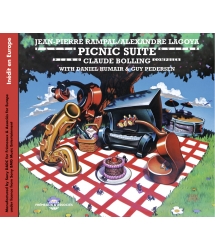
PICNIC SUITE
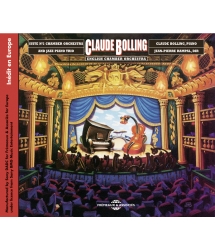
SUITE FOR CHAMBER ORCHESTRA & JAZZ PIANO TRIO
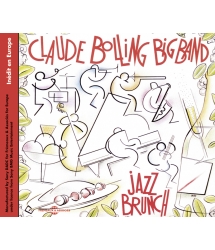
JAZZ BRUNCH LIVE RECORDING AT THE MERIDIEN PARIS
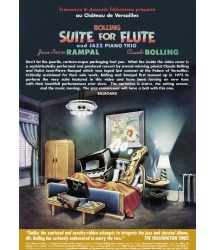
DVD - SUITE FOR FLUTE AU CHATEAU DE VERSAILLES










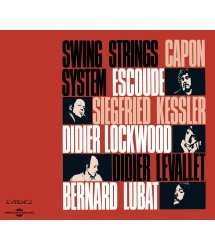
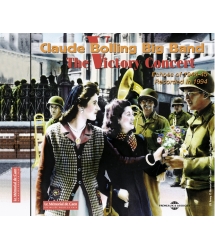
-
PisteTitleMain artistAutorDurationRegistered in
-
1HISPANIC DANCE (WITH A BLUE TOUCH)CLAUDE BOLLING00:05:341975
-
2MEXICAINECLAUDE BOLLING00:06:211975
-
3INVENTIONCLAUDE BOLLING00:04:061975
-
4SERENADECLAUDE BOLLING00:04:471975
-
5RHAPSODICCLAUDE BOLLING00:06:441975
-
6AFRICAINECLAUDE BOLLING00:04:281975
-
7FINALECLAUDE BOLLING00:05:511975
Bolling Lagoya FA 444
Claude Bolling
Alexandre Lagoya
Concerto for classic guitar
1. Hispanic Dance (with a blue touch) 5’34
2. Mexicaine 6’18
3. Invention 4’01
4. Sérénade 4’43
5. Rhapsodic 6’41
6. Africaine 4’24
7. Finale 5’51
All compositions by Claude Bolling
Alexandre Lagoya : guitare
Claude Bolling : piano
Michel Gaudry, Marc Michel : contrebasse
Marcel Sabiani, André Arpino : batterie
JAZZ & CLASSIQUE : LE MARIAGE INSOLITE
L’idée d’associer jazz et classique a souvent inspiré des personnalités musicales aussi diverses que George Gershwin, Dave Brubeck, Jacques Loussier voire des groupes comme le Modern Jazz Quartet de John Lewis ou les Swingle Singers. Pour sa part, Claude Bolling aborde ce type d’expérience en 1965 à l’occasion de “Jazz Gang Amadeus Mozart”, savoureux enregistrement en forme de gag musical, où la “Marche Turque” louche vers un jazz-dixieland débridé, teinté d’un humour à la Spike Jones.Quelque temps plus tard, le grand pianiste Jean-Bernard Pommier, lauréat du concours Tchaïkovski, partenaire occasionnel de Claude Bolling dans plusieurs émissions de télévision, lui demande une composition fondée sur le dialogue entre deux pianos, l’un jazz, l’autre classique. De cet échange entre deux langages musicaux se conjuguant dans une création commune naît en 1972 la “Sonate pour deux pianistes”, premier jalon de ce que les américains vont bientôt appeler la “Crossover Music”.Enthousiasmé par la “Sonate”, le célèbre flûtiste Jean-Pierre Rampal commande alors à Claude Bolling une œuvre associant son style de flûte classique au piano jazz. Dès sa sortie en 1976, cette “Suite pour Flûte et Piano Jazz Trio” devient un gigantesque phénomène musical aux U.S.A., en restant 2 ans en tête du hit-parade et se maintenant 530 semaines dans le classement de “Billboard”.Rapidement le Disque d’Or est décerné à la “Suite” suivi maintenant par le Disque de Platine. Le phénomène se transforme en déferlante quand, de ce mariage fécond entre jazz et classique, naît une heureuse progéniture. En effet, l’état de grâce se renouvelle avec Alexandre Lagoya, Pinchas Zukerman, Yo-Yo Ma, Maurice André et l’English Chamber Orchestra dans une série de compositions où Claude Bolling agence avec bonheur des combinaisons instrumentales subtiles et colorées.«Ayant beaucoup apprécié la “Suite pour Flûte et Piano Jazz Trio”, Alexandre m’a à son tour commandé un concerto pour guitare classique et piano jazz trio», raconte Claude Bolling. «Ce fut une nouvelle gageure car la difficulté résidait dans le mariage des sonorités de ces deux instruments. Pour que le piano ne domine pas la guitare, la technique d’écriture a nécessité une attention particulière.»
Stéphane Lerouge
JAZZ & CLASSICAL: THE STRANGE UNUSUAL MARRIAGE
The idea of associating jazz with classical has often inspired musical personalities as diverse as George Gershwin, Dave Brubeck, Jacques Loussier, and even groups such as the Modern Jazz Quartet of John Lewis or the Swingle Singers. As far as Claude Bolling is concerned, this type of experience was first approached in 1965 with “Jazz Gang Amadeus Mozart”, a savory recording in the form of a musical gag, where the “Turkish March” canters towards unbridled dixieland jazz, tinted with Spike Jones humor.Later on, the young pianist Jean-Bernard Pommier, winner of the Tchaikovsky prize, who had performed with Claude Bolling in several television programs, asked him to compose a piece based on a dialogue between two pianos, one jazz, the other classical. From this exchange between two musical languages joining together in a single creation, the “Sonata for Two pianists” was born in 1972, the first landmark in what the Americans would soon call “Crossover Music”.Enthused by the “Sonata”, the renowned flutist Jean-Pierre Rampal asked Claude Bolling to write a musical piece associating his classical flute and the jazz piano. In 1970, as soon as it was published, the “Suite For Flute and Jazz Piano Trio” became a gigantic musical phenomenon in the United States, keeping its number one position for two years and remaining for 530 weeks on the “Billboard” chart.Soon, the “Suite” attained Gold Record status, followed by Platinum, and this happy marriage between jazz and classical music gave birth to a number of happy offsprings. Indeed, the état de grâce is renewed with Alexandre Lagoya, Pinchas Zukerman, Yo-Yo Ma, Maurice André and the English Chamber Orchestra in a series of compositions where Claude Bolling arranges subtle and colorful instrumental combinations.«Alexandre who had loved the “Suite For Flute and Jazz Piano Trio” then challenged me to write a guitar concerto», says Claude Bolling, «For me it was a new wager. The difficulty was in associating both instruments. The writing needed very special attention so that the piano would not predominate over the guitar».
Stéphane Lerouge
NOTE SUR L’ŒUVRE
• La première partie de l’œuvre s’intitule “Hispanic Dance”. Elle se développe essentiellement autour d’un thème de caractère sud-américain vif et haut en couleurs, qui disparaît de temps à autre au profit de séquences “Bluesy” plus ou moins longues pour réapparaître dans des présentations constamment variées. C’est en quelque sorte un “Rondo” qui permet au compositeur de donner libre cours à son imagination et de faire notamment alterner, en créant d’heureux contrastes entre le rythme à 5/4 et celui à 4/4 plus Low Down des séquences de jazz-blues.
• Le tempo en apparence hésitant d’un groupe de “Mariachis” a inspiré à Claude Bolling le rythme à 5/8 qui anime une grande partie de la seconde pièce de son concerto : “Mexicaine”. Ici, le thème initial est d’inspiration d’Amérique Centrale. Cette fois, et en opposition avec le morceau précédent, la guitare nous fait entendre un chant très nostalgique et dépouillé qui s’enfle peu à peu pour prendre un tour dramatique à la faveur d’un développement auquel participent le piano, la basse et la batterie, et qui ouvre le champ au second thème d’inspiration jazz celui-là
• La troisième partie, “Invention”, a la forme d’une pièce de J.S. Bach. Elle se développe tout d’abord de façon traditionnelle grâce à un thème de caractère baroque que reprennent tour à tour le piano et la guitare, avec le soutien régulier et précis de la batterie et de la basse. Viennent ensuite deux improvisations qui se déroulent sur le cannevas harmonique du motif principal, la première étant confiée au piano, la seconde à la contrebasse. Oubliée un instant, la guitare fait sa réapparition et, reprenant son pétillant dialogue avec le piano, conduit cette page à sa conclusion.
• La “Sérénade” qui suit, débute avec un motif en arpèges largement développé harmoniquement par la guitare seule, grâce à des accords riches en notes de passages et en notes étrangères. A l’entrée du thème au piano, ce motif à trois temps donne naissance à une sorte de lente samba “bossa-nova” pleine de charme et de fraîcheur où la guitare continue à égrener ses arpèges, tandis que batterie et basse affirment le rythme caractéristique. Ce sont ensuite différents développements marqués jusqu’à la fin de la pièce par l’ostinato rythmique qui découle des arpèges initiaux.
• Le cinquième morceau “Rhapsodic” s’ouvre par une longue suite d’accords parfaits majeurs et mineurs sur pédale de dominante, confiés à la guitare. Un nouveau dessin qui n’est pas sans évoquer le motif en arpèges de la “Sérénade”, nous conduit à un autre thème d’abord exposé par la contrebasse, puis par le piano et la batterie, qui lui, a l’allure d’une ballade. Tous ces éléments vont se retrouver ensuite différemment présentés à l’occasion de plusieurs variations fondées notamment sur des doublements de tempo. On notera également que cette page particulièrement intense au niveau de l’expression, est celle qui requiert le plus de virtuosité de la part du guitariste.
• Le mouvement intitulé “Africaine” est une page singulièrement dynamique et haletante fondée sur deux thèmes principaux : un premier assez court et de caractère incantatoire exposé par la guitare et un second plus mélodique, mais complexe rythmiquement, exposé par le piano. Une fois encore, sur le plan formel, le compositeur ne se laisse pas enfermer dans un moule précis. Il développe ses thèmes, les mélange en fonction d’une imagination sonore et d’un désir d’expression constamment guidés par un très sûr instinct de l’équilibre des durées.
• Ce concerto se termine avec un mouvement qui est une reprise et un mélange des deux thèmes de “Hispanic Dance” et de “Mexicaine” dans un développement brillant en forme de “Final”.
Serge Kaufman
NOTES ABOUT THE WORK
• The first movement of the work is entitled “Hispanic Dance”. It develops essentially from a characteristic South American theme, vivacious and brightly hued, which gives way now and again to blues sequences of varying length and then reappears, metamorphosed. The movement is a sort of Rondo, which allows the composer to give free rein to his imagination and, more particularly, to alternate the rhythm from the 5/4 to the Low Down 4/4 of his more seductive jazz-blues.
• The capricious tempos characteristic of Mexican street musicians, or mariachis inspired the 5/8 rhythm that animates it large part of the second movement, “Mexicaine”. The initial theme is derived from Central American popular music. Contrary to the preceding movement, the guitar here focuses our attention on a very nostalgic and thin-textured chant, which swells little to assume a more dramatic coloration by means of a development in which the piano, bass and drums participate and which paves the way for the second theme, this one jazz-inspired.
• The third movement “Invention”, has the imitative form of a J.S. Bach piece. It begins in traditional fashion, with a theme of baroque character that the piano and guitar toss back and forth over a neat but insistent ostinato from the bass and drums. In time, two improvisatory sections emerge based on the harmonic fabric of the principal theme, the first of them given to the piano, the second to the double bass. Neglected for a moment, the guitar now makes its reappearance and, resuming its sparkling dialogue with the piano, leads the movement to its conclusion.3
• The “Serenade”, wich follows, begins with a motif in slow arpeggios, developed harmonically by the solo guitar, its chords enriched by added notes of various kinds (passing tones and neighboring tones). At the entry of the themes, played by the piano, this motif in triple time gives rise to a sort of a slow samba bossa nova, full of charm and naïveté, wherein the guitar continues to pluck its arpeggios one by one as the drums and bass affirm the characteristic rhythm. Other developments follow, marked toward the end of the movement by the rhythmic ostinato that is born of he opening arpeggio motif.
• The fifth movement “Rhapsodic” opens with a long series of perfect major and minor triads over a dominant pedal point, given to the guitar. A new pattern which in some ways evokes the arpeggio motif of the “Serenade”, leads us to another theme played first by the double bass, then by the piano and drums, which summons up the feeling of a ballad. All these elements are then combined in several variations based chiefly on the doubling of tempo. It is also to be noted that this passage is one of the most intense and requires more skill on the part of the guitarist.
• The movement entitled “Africaine” is a fast-paced and strongly accented section based on two principal themes : the first, very short and like an incantation in mood; the second, more melodic but rythmically complex. Once more hewing to the classic form, the composer still does not let himself become imprisoned in a too-exacting mold. He develops his themes, mixing them with an imaginative flair for sound and an unfaltering creativity of musical idea, guided always by a keen sense of timing.
• This concerto ends with a movement which is a retaking and a mixing of the two themes of the “Hispanic Dance” and the “Mexicaine” in a brilliant development in the form of “Finale”.
Serge Kaufman
CLAUDE BOLLING
Six fois lauréat du Grand Prix du Disque en France, Claude Bolling a été plusieurs fois nominé aux Etats-Unis pour le Grammy Award et connaît depuis longtemps une célébrité internationale pour ses talents de compositeur, arrangeur, chef d’orchestre et pianiste.Né à Cannes, Claude Bolling s’est révélé à 14 ans comme un prodige du piano-jazz et a débuté très tôt dans des activités professionnelles. Il avait reçu un solide enseignement de l’harmonie et du contrepoint, mais avait acquis la plupart de ses connaissances musicales en écoutant des disques. Ses premiers enregistrements ont été réalisés à 18 ans, avec son propre groupe de jazz Dixieland, et il est vite devenu l’un des musiciens de jazz les plus populaires d’Europe.Grâce à ses contacts fréquents, avec de nombreux jazzmen américains expatriés en Europe dans les années 1950-60, Claude Bolling a cotoyé toute l’histoire du jazz au contact de ses plus grands innovateurs. Son guide en la matière fut Duke Ellington, qui avait lui-même une grande admiration pour Bolling et appréciait énormément sa manière d’interpréter ses compositions.Compositeur prolifique, Claude Bolling a écrit plus d’une centaine de partitions pour la télévision et le cinéma, composant la musique de films comme “Borsalino”, “The Awakening”, “Willie and Phil”, “California Suite”, “The Silver Bears”, “Louisiane” et “Le Magnifique”.Claude Bolling a enregistré du ragtime, du boogie-woogie, du blues, des thèmes populaires, et il est surtout connu par ses propres compositions qui mêlent de façon unique la musique jazz, pop et classique. C’est ce style, connu sous le nom de “Crossover Music”, qui permit à Claude Bolling d’entrer dans l’histoire de la musique, avec la composition aujourd’hui célèbrissime “Suite pour Flûte et Piano Jazz Trio”.L’intérêt et l’engouement suscités par la “Suite pour Flûte et Piano Jazz Trio” a incité d’autres musiciens classiques de premier ordre, tels que Pinchas Zukerman, Alexandre Lagoya, Yo-Yo Ma, Maurice André, Hubert Laws et l’English Chamber Orchestra, à rechercher les compositions de Claude Bolling pour leurs instruments respectifs. Bolling a répondu par une abondante production dans son style de Crossover Music, toujours basé sur le même trio, avec la “Suite pour Violon, le Concerto pour Guitare Classique, la Suite pour Violoncelle”, et bien d’autres ont suivi.Il dirige le plus célèbre Big Band de jazz européen, qui a déjà travaillé avec des musiciens et des chanteurs de jazz et de musique populaire aussi connus que Dizzy Gillespie, Lionel Hampton, Joe Williams, Carmen McRay, et récemment avec Stéphane Grappelli.
CLAUDE BOLLING
Claude Bolling, six times a winner of the French Grammy award Le Grand Prix du Disque and nominated several times for the American Grammy has received consistent international acclaim as a composer, conductor arranger, and pianist.Born in Cannes, France, Bolling was recognized as a jazz piano prodigy at the age of 14 and soon began to make professional appearances. He had formal training in harmony and counterpoint, but acquired most of his musical education by listening to records. His first recordings were made with his own Dixieland group it when he was 18, and he subsequently became one of the most popular jazz musicians in Europe.Bolling’s frequent contact with the numerous expatriate jazz musicians in Europe during the 1950’s and 60’s exposed him to the entire history of jazz as performed by its major innovators. His mentor was Duke Ellington, who greatly admired and praised Bolling’s interpretations of his compositions.A prolific composer, he has written over hundred scores for TV and feature films such as “Borsalino”, “The Awakening”, “Willie and Phil”, “California Suite”, “The Silver Bears”, “Louisiana” and “Le Magnifique”.Bolling has recorded ragtime, boogie-woogie, blues, popular standards, and most widely known, his own compositions in a unique mixture of pop, jazz, and classical styles. It was the latter style, known commonly as “Crossover Music”, that enabled Bolling to make musical history with his by-now famous composition “Suite For Flute and Jazz Piano Trio”.The interest and excitement generated by “Suite For Flute and Jazz Piano Trio” promoted other leading classical musicians, including Pinchas Zukerman, Alexandre Lagoya, Yo-Yo Ma, Maurice André, Hubert Laws and the English Chamber Orchestra to seek Bolling compositions for their respective instruments. Bolling responded with it prolific output in his classical crossover style still based on his trio : “Suite For Violin”, “Concerto For Classic Guitar”, “Suite For Cello”, and many others followed.He is leading the most famous European jazz big band which has worked with well known Jazz and popular instrumentalists and vocalists, including Dizzy Gillespie, Lionel Hampton, Joe Williams, Carmen McRay and recently with Stéphane Grappelli.
ALEXANDRE LAGOYA
Né à Alexandrie en 1929 d’un père grec et d’une mère italienne, il commence ses études musicales et de guitare à l’âge de 8 ans. A 13 ans il donne son premier récital et à 15 ans, il enseigne déjà la guitare et le solfège. Après avoir donné plus de 500 concerts, il s’installe à Paris, où la France devient son pays d’adoption.Poursuivant sa carrière pédagogique et artistique, il effectue une immense tournée de concerts dans tous les pays d’Europe.En 1952, il épouse la célèbre guitariste française Ida Presti avec laquelle il forme le duo Presti-Lagoya. Ils fondent alors ensemble une classe de guitare à la Schola Cantorum. A travers leurs 15 tournées internationales, qui comprennent plus de 2000 concerts, les compositeurs D. Lesur, A. Jolivet, F. Poulenc, L. Alibert, P. Petit, H. Tomasi, S. Lancen, J. Wiener, J. Rodrigo, M. C. Tedesco, H. Villa-Lobos, F.M. Torroba, leur dédient leurs œuvres.Après quinze années de recherches instrumentales avec Ida Presti, ils ouvrent de nouveaux horizons à la technique de la guitare :• une nouvelle position de mains,• découvrant la façon de faire les trilles sur deux cordes jusqu’alors faites sur une,• employant une nouvelle position pour obtenir une plus grande rapidité dans le pizzicato et perfectionner la technique du staccato.Alexandre Lagoya est demandé à plusieurs reprises pour enseigner la guitare dans les universités aux U.S.A. et notamment aux J.M.C. (Canada) et dirige à partir de 1960 la classe de guitare à l’Académie Internationale d’Eté de Nice, formant ainsi de nombreux élèves qui occupent des postes dans les Conservatoires parmi les plus importants à travers le monde.Chaque année, Alexandre Lagoya est invité à participer en tant que membre du jury des plus importants concours nationaux et internationaux. Il devient professeur au Conservatoire National Supérieur de Musique de Paris en octobre 1969, date de la création d’une classe de guitare. Alexandre Lagoya donne des concerts dans le monde entier : il joue sous la direction d’éminents chefs avec les plus grands orchestres symphoniques. Régulièrement, il est sollicité par les plus importants festivals nationaux et internationaux. Alexandre Lagoya est considéré comme le plus extraordinaire guitariste de notre temps. Il a enregistré de nombreux disques.En 1965, le gouvernement français le fait Commandeur du Mérite Culturel et Artistique; en 1972. Chevalier du Mérite National; en 1974, Chevalier des Arts et Lettres pour son action en faveur de la musique à travers le monde. Deux décorations lui ont été décernées par le gouvernement de l’U.R.S.S. en 1964.Malgré toutes ses activités, cet homme souriant, généreux, direct, aimait la jeunesse qu’il aidait et conseillait. Tout l’intéressait, la peinture, l’architecture, la littérature, la nature, les animaux... Il aimait voyager, mais c’est avec un infini plaisir qu’il retrouvait sa demeure située dans un cadre encore privilégié.
ALEXANDRE LAGOYA
He began his musical studies and the guitar at the age of 8. At 13, he gave his first solo recital, and at 15, he gave guitar and solfeggio lessons. After having given more than 500 concerts, he moved to Paris, and France became his adopted country.While pursuing his teaching and artistic career, he was also able to accomplish a lengthy concert tour covering many, European countries.In 1952 he married the famous guitarist Ida Presti with whom he formed the Presti-Lagoya duet. Together, they created a class in guitar at the Schola Cantorum. They embarked on 15 international tours which included more than 2000 concerts, and many composers including D. Lesur, A. Jolivet, F. Poulenc, L. Alibert, P. Petit, H. Tomasi, S. Lancen, J. Wiener, J. Rodrigo, M.C. Tedesco, H. Villa-Lobos, and F.M. Torroba, have dedicated works to the couple.After 15 years of instrumental research with Ida Presti, he developed new techniques for the guitar:• A new right hand position which gives greater volume to the instrument,• A way to perform trills on two strings instead of one,• A new position in order to obtain greater speed when executing the pizzicato and perfecting the staccato technique.Alexandre Lagoya is repeatedly asked to teach guitar at American universities and at J.M.C. (Canada). From 1960 he has been in charge of the guitar class at the International Summer Academy in Nice, teaching numerous musicians who now occupy, positions in conservatories throughout the world.Alexandre Lagoya is considered to be one of’ the most extraordinary guitarists of our time. He has recorded many albums, and gives concerts the world over, often performing under the direction of eminent conductors with the greatest symphonic orchestras. He is regularly solicited by the most important national and international music festivals, and is invited to participate in important national and international competitions as a member of the jury every year. Also, he has been a professor at the Paris National Conservatory of Music since October 1969, when the guitar class was created.In 1965 the French government honored him with the title of Commander of Cultural and Artistic Merit : in 1972, Chevalier of National Merit, and in 1974, Chevalier of Arts and Letters for his action in favor of music throughout the world. He was awarded two medals by the Soviet government in 1964.Despite all his activities, this amiable, generous, straight forward man always had time to help and advise. Everything interested him : painting, architecture, literature, nature, animals... He loved to travel but found infinite pleasure in returning to the comfort of his home.
CD TITRE, ARTISTE © Frémeaux & Associés (frémeaux, frémaux, frémau, frémaud, frémault, frémo, frémont, fermeaux, fremeaux, fremaux, fremau, fremaud, fremault, fremo, fremont, CD audio, 78 tours, disques anciens, CD à acheter, écouter des vieux enregistrements, albums, rééditions, anthologies ou intégrales sont disponibles sous forme de CD et par téléchargement.)
